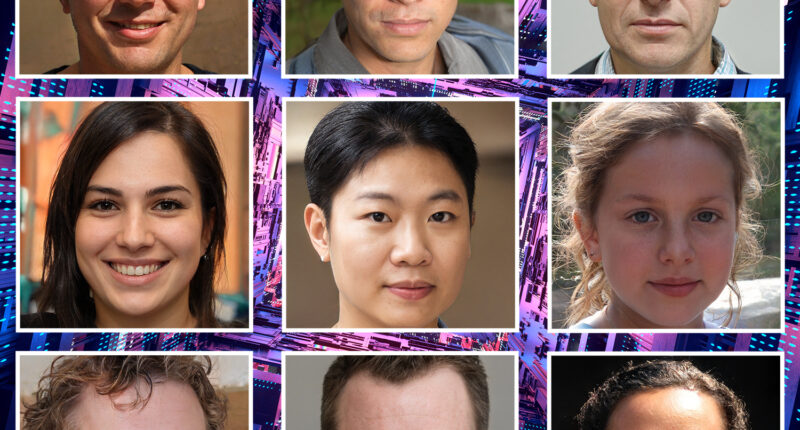NONE of the people in the picture at the top of this article can be trusted.
They look like anyone you could see down the shop, and are nearly indistinguishable from real humans.
But they have never been born – they are merely faces created by the AI tool from “thispersondoesnotexist.com“.
Every click produces a unique and photorealistic image from billions upon billions of possible combinations.
It ends up with a unique face every time – mostly nearly indistinguishable from a real human beyond a few small glitches.
You would not bat an eyelid if you saw them walking down the street or had the face pop up on your social media feed.


The technology is developing quickly as well, with experts telling The Sun Online at times it is already indistinguishable from real photos.
With the rise of these AI generated images, increasingly sophisticated deepfake video and audio, fast developing chatbots and computer developed data – what is next?
“We are in an arms race – we are in an arms race, with both sides using advanced AI,” tech expert Dr Mike Seymour told The Sun Online.
It is feared this technology could be used to spread dangerous misinformation and potentially be used by scammers who can create entire new identities using AI.
Most read in Tech
Dr Seymour recently showed the power of this technology – consulting with a VFK team from Adapt Entertainment to convert every actor in the film The Champion from speaking German to English by using AI to render their faces.
“It is already indistinguishable. It just looks like the film was shot in English,” he told The Sun Online.
He warned the public needs to be more informed to make sure they treat what they encounter online with scepticism amid the rise of AI.
But the ease of access to this AI technology is ramping up the spread – and it’s they are only going to become more common.
“The problem with anything in this area is that it is getting easier and easier to produce plausible fakes so it lowers the bar for who can attempt such actions,” said Dr Seymour.
And one study has revealed people find AI generated faces are already indistinguishable from humans and “more trustworthy” than the real deal.
The experiments, compiled by the University of California, found that AI faces were 7.7 per cent more trustworthy.
“This may be because synthesized faces tend to look more like average faces which themselves are deemed more trustworthy,” the study said.
“Regardless of the underlying reason, synthetically generated faces have emerged on the other side of the uncanny valley.”
Cassidy Bereskin, a doctoral researcher from the Oxford Internet Institute, told The Sun Online that we now live in a world where “seeing is no longer believing”.
“Deepfakes and generative AI models are becoming increasingly sophisticated and accessible to the masses,” she said.
“They are hyper-realistic and no longer only available for programmers.
“These twin developments threaten to increase the supply, scale, spread, and believability of online misinformation.”
She went on: “Deepfakes have already inflicted significant reputational and psychological harm in pornography.
“They have also been weaponized to undermine democracy, national security, and our economy, such as being used in financial scams.
“Their increasing volume and believability threaten to exacerbate the worst risks in our digital world.”
Both Dr Seymour and Ms Bereskin urged the public to become more informed to help themselves navigate the increasingly challenging information world online.
“It is essential for users to seek out information from high-quality sources and to keep in mind that seeing is no longer believing,” said Ms Bereskin.
“This technology is persuasive, so naturally bad actors will try and use it, but the best defence we have is an informed public, after all for years we have been able to do brilliant visuals still image fakes with Photoshop, but because people know that, they have naturally developed healthy skepticism when images seem unlikely or odd,” said Dr Seymour.
He said the main awareness needed to be developed is the ability to spot fake videos – as stills and written stories are already common.
Dr Seymour continued: “We need to update our current laws to catch up, but we do already have libel and copyright laws.
” It is already illegal to impersonate someone or use their likeness without permission.
“The current laws are a great start, but the technology is moving so quickly that more work needs to be done to catch up.”
Jyothsna Gurumurthy, a doctoral researcher at the University of Oxford, told The Sun Online there needs to be more focus on regulation to algorithmic generator AIs.
“There could new forms of synthetic media besides deepfakes that bring about their own issues, but the use of artificially generated data will continue to create new information battles, since they are getting more sophisticated and difficult to discern from reality,” she said.
Dr Seymour added: “We need to update our current laws to catch up, but we do already have libel and copyright laws. It is already illegal to impersonate someone or use their likeness without permission.
“The current laws are a great start, but the technology is moving so quickly that more work needs to be done to catch up.”
He added that the AI battle could actually go the other way – with real photos instead finding themselves dismissed as “fakes”.
“We need to beware of people claiming things the other way around,” he said.
“There have already been South American politicians claiming videos uncovered of them with multiple prostitutes are ‘deep fakes’ – when most experts agree the videos are real.
“But as the saying goes ‘a lie can go around the world twice before truth can get out of bed’.”
He warned AI constructions of legal documents and banking documents could also be a worrying development in the online space.
“Documents that are completely plausible and contain enough bits of real information woven together to make you believe they are 100% real and authentic,” he warned.
The world has already seen some fake news spread – such a AI generated deep fake video Ukrainian president Volodymyr Zelensky telling his troops to lay down their arms last March.
Such a piece of misformation could have been devastating and sowed chaos if it ever got traction.
But thankfully, the amateur attempt at impersonating Zelensky was laughed off due to its shoddy appearance.










